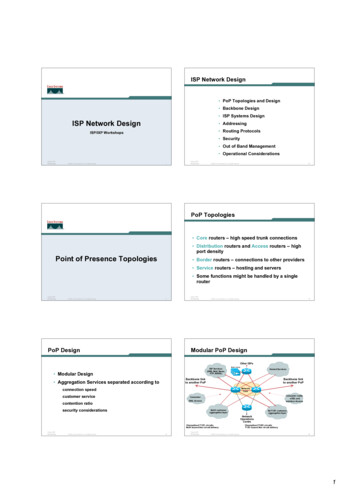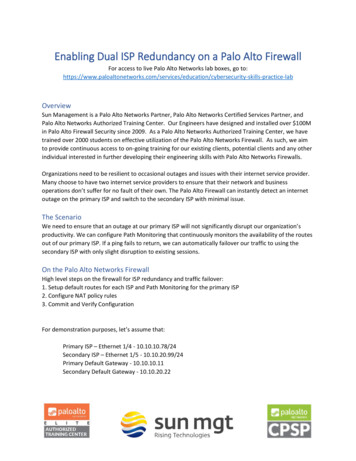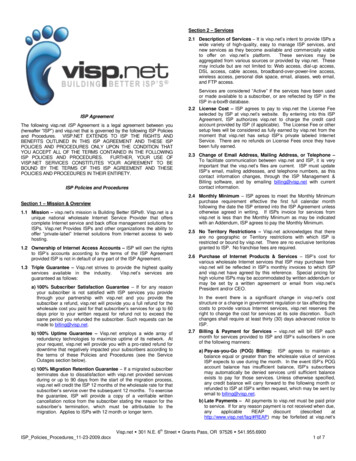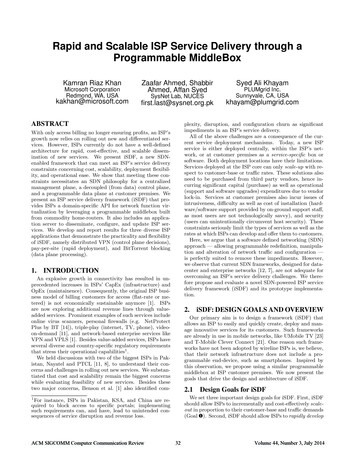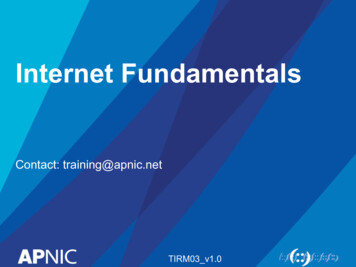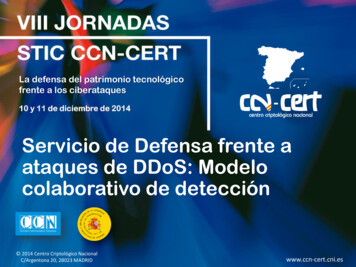
Transcription
2020 ISPAppendix 8.Resilienceand ClimateChangeJuly 2020
Important noticePURPOSEThis is Appendix 8 to the Final 2020 Integrated System Plan (ISP), available at ns/integrated-system-plan-isp.AEMO publishes this 2020 ISP pursuant to its functions under section 49(2) of the National Electricity Law(which defines AEMO’s functions as National Transmission Planner) and its broader functions under theNational Electricity Rules to maintain and improve power system security. In addition, AEMO has had regardto the National Electricity Amendment (Integrated System Planning) Rule 2020 which commenced on 1 July2020 during the development of the 2020 ISP.DISCLAIMERThis document or the information in it may be subsequently updated or amended. This document does notconstitute legal or business advice, and should not be relied on as a substitute for obtaining detailed adviceabout the National Electricity Law, the National Electricity Rules, or any other applicable laws, procedures orpolicies. AEMO has made every effort to ensure the quality of the information in this document but cannotguarantee its accuracy or completeness.Accordingly, to the maximum extent permitted by law, AEMO and its officers, employees and consultantsinvolved in the preparation of this document: make no representation or warranty, express or implied, as to the currency, accuracy, reliability orcompleteness of the information in this document; and are not liable (whether by reason of negligence or otherwise) for any statements or representations in thisdocument, or any omissions from it, or for any use or reliance on the information in it.VERSION CONTROLVersionRelease dateChanges1.030/7/2020Initial release 2020 Australian Energy Market Operator Limited. The material in this publication may be used inaccordance with the copyright permissions on AEMO’s website.
ContentsSummary6A8.1.Introduction8A8.1.1Energy system resilience8A8.1.2Features of a resilient NEM10A8.1.3Cyber security12A8.1.4Fuel security13A8.2.Resilience in the 2020 ISP14A8.3.Forecasting climate impacts on energy systems17A8.3.1The Electricity Sector Climate Information (ESCI) Project19A8.3.2Climate vulnerability scan20A8.4.Planning for a climate-resilient network29A8.4.1Example network planning climate considerations in the NEM29A8.4.2International network planning climate considerations31A8.5.Next steps34TablesTable 1How resilience has been considered within the optimal development path15Table 2Summary energy system climate vulnerabilities17Table 32020 ISP scenario dimensions relating to climate-resilience19Table 4Identified energy system vulnerabilities to heat21Table 5Identified energy system vulnerabilities to bushfire24Table 6Identified energy system vulnerabilities to wind25Table 7Identified energy system vulnerabilities to projected change in rainfall26Table 8Priority forecasting recommendations arising from climate vulnerability scan28Table 9Recommendations arising from NSP consultations, and proposed responses31Table 10Primary recommendations from report into incorporating climate-related risks, andAEMO’s responses32Secondary recommendations from report into incorporating climate-related risks,and AEMO’s responses33AEMO actions to enhance energy system resilience34Table 11Table 12 AEMO 2020 2020 ISP Appendix 8. Resilience and Climate Change3
FiguresFigure 1Conceptual relationships between definitions relative to impact magnitudeFigure 2Projected global average surface temperature change20Figure 310% Probability of exceedance temperature (⁰C) for 2000-2019 (left) and 2040-2059(right)21Figure 4Historical fire activity23Figure 5Projected change in high fire weather days23Figure 6Sea level trends from January 1993 to December 201027 AEMO 2020 2020 ISP Appendix 8. Resilience and Climate Change94
2020 ISP AppendicesAppendix 1. Stakeholder EngagementStakeholder engagement program and timelinesConsultation on Draft 2020 ISPAppendix 2. Cost Benefit AnalysisUnderstanding the cost benefit analysisDetermining the least-cost development pathfor each scenarioAssessing benefits of candidate developmentpaths under each scenarioTesting the resilience of candidate developmentpaths to events that may occurAppendix 3. Network InvestmentsNetwork investments in the optimaldevelopment pathCommitted ISP projectsActionable ISP projectsFuture ISP projects recommended withpreparatory activitiesOther future ISP projectsAddressing network congestionAlternatives consideredAppendix 4. Energy OutlookFuture energy supplies for a resilient powersystemUnlocking VRE through REZsManaging variable energy supplies throughenergy storages and firming technologiesDevelopment outlooks across scenariosNEM emission intensity with the least-costoptimal development pathAppendix 6. Future Power System OperabilityPower system operability models and inputNEM-wide operability outlookRegional risks and insightsAppendix 7. Future Power System SecurityRenewable Integration StudySystem strength outlookInertia outlookREZ opportunitiesSouth Australia in transitionAppendix 8. Resilience and Climate ChangeResilience in the 2020 ISPForecasting climate impacts on energy systemsPlanning for a climate-resilient networkNext stepsAppendix 9. ISP MethodologyOverview of ISP methodologyInputsEngineering assessmentMarket modellingModel outputsAppendix 10. Sector CouplingHydrogenEVsGasEnergy efficiencyBioenergyAppendix 5. Renewable Energy ZonesIntegrating large volumes of VREREZ framework and design principlesISP REZ developmentREZ scorecards AEMO 2020 2020 ISP Appendix 8. Resilience and Climate Change5
SummaryThis Resilience and Climate Change appendix provides detail on changes that are impacting the resilience ofthe NEM, including climate change. It explores solutions and ongoing work that will evaluate and mitigatethese risks to Australian energy consumers.Key insightsPower system resilience is the ability of the system to limit the extent, severity, and duration of systemdegradation following an extreme event. It has long been embedded in good energy system planningand operation practices but is in long-term decline, necessitating a renewed focus. The decline inresilience is driven by numerous compounding factors: Climate change is increasing the frequency and magnitude of physical weather hazards. Cyber hazards are increasing risks to software-based system solutions. New generation sources are increasingly being dispersed from central locations with strong networklinks to the main load centres, into remote, electrically weaker, areas of the grid distant from the loadcentres, changing the risks and vulnerabilities of the system. System control services are increasingly complex, and the power system is reliant on the integratedtesting and performance of these systems to avoid the risks of cascading system impacts. Societal services are increasingly interconnected risking cascading societal impacts. An increasing focus on quantitative cost benefit analysis over good design principles, which excludesmitigation for risks that are difficult to quantify and value.Through the ISP stakeholder engagement process, stakeholders have expressed a strong desire forfurther consideration of resilience to climate events, and resilience more broadly.The 2020 ISP considers resilience in two main ways: Risk analysis and risk evaluation – where possible, risk processes consider both the impact of acuteand chronic hazards. Where captured, these risks contribute to the estimation of system reliability,security, and calculated project market benefits. While efforts have been taken to improve risk analysisand evaluation to capture resilience, many acute hazards remain excluded from this ISP due tolimitations in both climate and energy system modelling. Planning standards – planning standards consider resilience when developing physical designs, andtechnology solutions. Through this consideration, these solutions enhance system resilience, but maynot yet appropriately address all current and future risks.Due to the considerations for resilience in solution design, AEMO remains confident that the optimaldevelopment path will strengthen the resilience of the energy system, particularly with projects such asVNI West and Marinus Link accelerated relative to the projects’ optimal timings arising from risk andmarket benefit analysis alone. Additional actions and investments are required to avoid further decline inresilience over time.AEMO has undertaken reviews of current approaches to planning and design considerations regardinghow climate and other resilience factors are treated. Most countries have differing approaches toplanning for resilience, and no common approach in existing regulatory frameworks for dealing with AEMO 2020 2020 ISP Appendix 8. Resilience and Climate Change6
resilience to climate change or other resilience risks. In many cases, the approach is implied as part of“good engineering practice”, an approach that is increasingly challenged by regulatory frameworks, but isincreasingly necessary to support the integration of IBR. AEMO 2020 2020 ISP Appendix 8. Resilience and Climate Change7
A8.1. IntroductionThis appendix is part of the 2020 ISP, providing more detail on changes impacting the resilience of the NEM,and solutions and ongoing work that will evaluate and mitigate these risks to Australian energy consumers.The ISP sets out an optimal development path for the NEM that serves both power system needs (reliabilityand security) and public policy needs in the long-term interest of consumers. The reliability of the powersystem means that it will continually achieve a real-time, safe balancing of supply and demand for energy: seeSection A2.Resilience in the power system is well embedded in good energy system planning and operating practices. Inthe context of this ISP, AEMO has adopted the CIGRE definition: “the ability of a power system to limit theextent, severity, and duration of system degradation following an extreme event”1.Current limitations in both climate and energy system modelling mean that comprehensive modelling ofextreme weather and power system events is not yet possible. For example, many climate models do notcurrently represent extreme events like storm or cyclone events well, and their impact on the power systemcan be difficult to predict. As such, the benefits of resilient system designs to extreme events are not currentlycaptured within the ISP cost benefit analysis. AEMO will continue to advance consideration for climate risks indecision-making to ensure outcomes are as robust as possible.This appendix is structured in the following way: The characteristics of resilient energy systems. Where the 2020 ISP has considered physical climate risks, and associated implications. The direct and indirect exposure of energy systems to climate change. Domestic and international examples of climate risk mitigation. Further considerations and next steps.A8.1.1Energy system resilienceResilience has long been embedded in good energy system planning practices. It refers to the ability of asystem to resist, absorb, accommodate to, and recover from the effects of a hazard in a timely and efficientmanner2. There are numerous working definitions of power system resilience, including the definition ofresilience above, developed through CIGRE working group 4.47, that AEMO applies to this ISP.Resilience differs from, and extends beyond, other industry risk management definitions of ‘reliability’ and‘security’. Figure 1 shows the definitions and how they overlap to the degree that a hazard would beconsidered under the security or reliability definitions.1CIGRE C4.47 WG Members. 2019. Defining power system resilience reference paper. Electra No.306 – October 2019.2United Nations Resolution 69/283. Sendai Framework for Disaster Risk Reduction. 2015-203017. AEMO 2020 2020 ISP Appendix 8. Resilience and Climate Change8
Figure 1Conceptual relationships between definitions relative to impact magnitudeAustralian energy consumers have historically enjoyed the benefits of resilient energy systems; however,numerous compounding changes, described below, are eroding these benefits, so resilience requires arenewed focus: Power system transition – the rapid transformation of the power system and current marketarrangements continue to test the boundaries of the power system technical operating envelope. Newergeneration has little or no short-term overload capabilities, meaning they are unable to assist or preventcollapse for situations they have not inherently been designed for. While traditional generators are kept inlarge generator buildings, variable renewable generation sources (both VRE and DER) are exposed to abroad array of climate hazards. Traditional generation locations are well supported by strong meshednetworks with substantial redundancy; emerging generation hubs currently lack these characteristics,amplifying the impacts from physical climate risks. Climate change – energy systems face numerous challenges in a changing climate. Increasingly, energysystem vulnerabilities to heightened climate impacts, particularly extreme weather, are recognised asmaterial risks to individual assets, the integrated energy system, and society. Consumer demand forenergy, and increasingly generation supply, are significantly influenced by weather, increasing the powersystem’s climate exposure. System control services – Special Protection Schemes (SPSs) and Remedial Action Schemes areincreasingly used to defer investments in physical assets. The quantity of schemes is becomingchallenging, with increasing interdependencies with other schemes and protection settings, and sharedcommunication infrastructure. An increased reliance on software-based solutions, unless properlydesigned and fully tested (including comprehensive system-wide integration testing), could createunexpected exposures to cyber threats or risk of compounding effects. Cyber security – in the energy sector, the increasingly distributed supply chain, the pervasive use ofinformation and communications technology, and the convergence of Information Technology (IT) andOperational Technology (OT) are rendering critical systems and infrastructure across the countryincreasingly more at threat unless they are being well designed and maintained against the increasingthreat of cyber incursions. Societal integration – the role of energy in society is changing and becoming more integrated. Electricity,gas, water, transport, communications, health, and other services are increasingly interdependent.Consumers are more focused on services they want and need to run their business or use in their life, notthe amount or type of energy, and many of the services that they use rely on electricity as the primaryenergy source. Consumers are also focused on what they get for the cost of these services. With anincreasing reliance on services that depend on energy comes increasing expectations. The management of AEMO 2020 2020 ISP Appendix 8. Resilience and Climate Change9
hazards increasingly requires an integrated consideration of full societal implications consistent withcustomer expectations and willingness to pay. Quantitative cost benefit analysis – the use of quantitative cost benefit analysis has become central tothe justification of all regulated investments and market structures. Limitations in both climate and energysystem modelling mean that full risk quantification of acute hazards is impractical. Limitations in economicand social cost modelling used to develop value of customer reliability estimates for widespread and longduration outages were also acknowledge by the AER3. However, this does not diminish the importance ofunderstanding and managing these risks.Energy system planning involves complex engineering and analytical processes to understand and manageidentified risks to power system and consumer outcomes. These processes may not be fully capturing thedegradation in resilience. However, resilience thinking is broader than current process, extending to prudentrisk management against hazards that may not be specifically identified. This more holistic approach toresilience provides a richer understanding of emerging risks to power system, and through that to consumerand societal outcomes.To the degree that current processes allow, AEMO has sought to include cost-effective resilient characteristicsin the development of the solution design and technology that form the optimal development path.A8.1.2Features of a resilient NEMThe definition of resilience described earlier provides insight into the outcomes society could expect from aresilient energy system. As extreme events are by definition difficult to predict and desirable to minimise, theleading indicators of success must be identified. The resilience goals of society will be more likely to beachieved in a cost-effective manner when these characteristics are part of the design of future energysystems.A global program called 100 Resilient Cities4 has explored the characteristics of resilient systems in the contextof urban resilience. Many of these characteristics are embedded in good energy system planning practices,and the potential responses to build resilience are often quite similar. In its report to accompany the ISP, theBrattle group indicated that “many climate risks have similar potential responses, including consideration ofgeographic diversity of transmission lines, increasing physical robustness of the assets, increasing monitoringand the use of sensors for early alerts for potential severe events”5.Considering characteristics described in existing literature and good industry planning practices, AEMO hasidentified six features important to planning for a resilient energy system. Additional features may requireconsideration when developing cybersecurity, market and operational approaches to resilience. The sixfeatures are: Robust asset specifications – individual assets and assets systems are well constructed and managedusing robust design specifications. Specifications are designed to resist the majority of hazards in both thepresent and future operating environment. For long lead time items, an appropriate quantity of spares arekept to expedite recovery in the event of loss. Redundancy and operational flexibility – asset systems, and the system as a whole has sufficientoperational flexibility in the presence of increasing and coincident hazards to manage contingencies andreturn the system to a normal secure operating state. This includes flexibility or cost-effective redundancyin transmission paths, generation, and other energy resources.3AER. 2020. Widespread and Long Duration Outages – Value of Customer Reliability Consultation Paper, at f.4See http://www.100resilientcities.org/.5The Brattle Group. 2020. Potential for Incorporating Climate-Related Risks onto Transmission Network Planning, at em-plan-isp/2020-isp-inputs-and-assumptions AEMO 2020 2020 ISP Appendix 8. Resilience and Climate Change10
Effective control systems – control systems (including SPSs, system integrity schemes, and remedialaction schemes) are generally effective, automated, and do not require perfect foresight of the nature ofnon-credible contingencies and the inter-operability between various control schemes. If well designed,these schemes can absorb, rather than amplify, the impact of a contingency event. However, withincreasing prevalence of the range of schemes being introduced in an increasingly complex power system,care needs to be taken in the design and testing of the schemes. Key risks to the resilience of the powersystem depend on the availability and reliability of communications links in these systems, the interactionwith a range of other schemes and protection settings across the power system, ability to isolateequipment for maintenance, and the need for error reporting and alarming. To manage these risks, thereis a need to adhere to good design standards, which consider both credible and non-crediblecontingencies to avoid the risk of cascading failure. Islanding capability – if the power system is designed well and appropriate investments are made toenable this level of resilience, the power system should ideally be able to securely split down into regionalor even sub-regional electrical islands under extreme events, to minimise the total consumer impacts andaid rapid restoration. Geographic diversity – energy systems are normally designed to avoid single points of failure due tolocation specific hazards – however, this design principle is being challenged with coincident weatherpatterns now having a greater impact across large amounts of infrastructure (for example, high windsaffecting multiple generators). Transmission lines are separated over multiple, diverse corridors usinglooping or meshed designs. Connection points and generator hub locations are spatially distributed,diversifying both the exposure to hazards, and generation and load profiles – but it is only with sufficientnetwork that the underlying risk exposure to a common fuel source (e.g. wind or sun) can be managedthrough diversity with resources in other areas. Generation source diversity and ability to forecast – the portfolio of generation assets is diverse andconsiders weather and fuel-specific hazards. There is sufficient fuel flexibility and storage to manageshocks in fuel, supply chain availability, and water or wind droughts. Renewable generation locations havelocal weather measurement services that allow for effective now- and near-casting of output and hazards.Case study – Latrobe Valley to MelbourneThe Latrobe Valley, incorporating the towns of Moe, Morwell and Traralgon, is the location of Victoria’sbrown coal generation fleet. Given the historical importance of brown coal as a fuel source, transmissionlines that connect this region with Melbourne are of great significance. The transmission system designincludes both redundancy and geographic diversity, comprising three corridors with four lines (seecorridors in the map below).A system design that used a single corridor would have been less costly. Instead, the system wasdesigned to provide resilience against hazards using geographic diversity and an appropriate amount ofredundancy. As the location of generators shifts it is important that resilient designs are implementedwhere cost effective throughout the system to ensure energy consumers continue to experience thebenefits they have come to expect. AEMO 2020 2020 ISP Appendix 8. Resilience and Climate Change11
220kV330kV500kVA8.1.3Cyber securityThe increasingly distributed supply chain, the pervasive use of information and communications technologyand the convergence of IT and OT renders critical systems and infrastructure across the country increasinglymore vulnerable to compromise.Cyber security is becoming more important due to the increasing number, sophistication and intensity ofcyber-attacks to energy systems. The Finkel Review6 notes that, during the first publicly acknowledgedincident to result in a power outage, in December 2015 in Ukraine7, “restoration efforts were delayed as theattack disabled control systems, disrupted communications and prevented automated system recovery”.Market participants, including AEMO, are applying learnings from global incidents as part of their efforts tocounter the evolving cyber security threats facing the Australian energy sector, in particular ransomware andsystem compromise. Recent examples of attacks globally include: Taiwan’s state-owned CPC Corp impacting card payments (April/May 2020). Data breach at EDP in Portugal (April 2020). US natural gas compressor shut down for two days (February 2020).Protecting the Australian energy sector against cyber threats is a key part of ensuring energy systemresiliency. Recommendation 2.10 of the Finkel Review involves the ESB delivering an annual report whichincludes “an assessment of the Australian Energy Market Operator’s cyber security capabilities and third partytesting”.Over recent years there has been an increasing inter-relationship between NEM systems and ICT andconnectivity, which further increases the cyber threats to the system. Examples include supervisory controland data acquisition (SCADA) systems increasingly using internet connectivity to transmit control signals togenerators, as well as the growth of DER being connected to open networks for communication.6The Australian Government. 2017. Independent Review into the Future Security of the National Electricity Market, at -2017.pdf.7BBC. 2017. Ukraine power cut 'was cyber-attack', at https://www.bbc.com/news/technology-38573074 AEMO 2020 2020 ISP Appendix 8. Resilience and Climate Change12
The Brattle group also noted the link between planning the energy system and cybersecurity to mitigate risksassociated with different types of hazard often had similar solutions:“Planning for climate resilience may overlap with other areas of resilience planning, notably cyber security.Increasing the use of advanced sensors and communication is likely to significantly increase resilience andmitigate the risks and potential damage from extreme events”.In 2018, AEMO began working with industry on a proactive, voluntary work program to improve cybersecurity preparedness in the energy sector. This work included forming a Cyber Security Industry WorkingGroup (CSIWG) and developing an Australian Energy Sector Cyber Security Framework (AESCSF) specificallyto assess the Australian energy sector’s current cyber security maturity and inform increased cyberpreparedness8.AESCSF has initiated several streams of work to examine, explore and uplift cyber security across the energysector. The Readiness and Resilience Working Group (RRWG) was established to improve the cyber securitymaturity and preparedness of energy sector organisations. The aim of the RRWG is to: Build and propagate a best practice approach for the energy sector to prepare for, prevent, detect,respond and recover from cyber security incidents, and Strengthen cyber security incident response and recovery arrangements at a state and national level toeffect a coordinated and swift management of incidents to reduce impacts and maintain communityconfidence.The RRWG coordinates the energy sector’s involvement in sector specific, state, and national level cyberexercises. The 2019 national electricity exercise (GridExV) jointly led by AEMO and the Australian CyberSecurity Centre examined: Improving awareness and mitigation of cyber security threats and vulnerabilities in the energy sector. Sharing knowledge and propagating best practices to improve cyber security arrangements in the energysector. Strengthening organisations’ arrangements to prevent cyber security incidents causing disruption tobusiness operations. Improving organisations’ arrangements to detect and alert others of cyber security incidents affecting theenergy industry. Strengthening coordination of cyber security response and recovery arrangements, within individualorganisations and across the energy industry.A8.1.4Fuel securityEnergy and fuel security are key concepts that also need to be considered when planning and designing aresilient energy system. In June 2020, the Australian Government announced a fuel security package, whichincludes working to increase Australia’s domestic fuel storage capacity 9. AEMO will work with the AustralianGovernment where necessary to assist in implementing this package. Increased storage and flexibility of fuelwill enhance the resilience of Australia’s energy systems to a variety of supply chain impacts.Planning for a system resilient to cyber-attacks and providing fuel security involves being reflective andlearning from past incidents, being resourceful in how we use resources, ensuring integration, and alsodesigning a system that is robust in the face of an increasing frequency of events in the future.8AEMO. 2019. Australian Energy Sector Cyber Security Framework, at cyber-security/aescsf-frameworkand-resources.9The Australian Government. 2020. Australia’s future fuel security package, at ge. AEMO 2020 2020 ISP Appendix 8. Resilience and Climate Change13
A8.2. Resilience in the2020 ISPWhile the concept of resilience is considered throughout the 2020 ISP and influences technical systemmodelling, economic modelling, transmission augmentation design and REZ design, AEMO has alwaysconsidered resilience in long-term planning.The inaugural ISP in 201810 also considered resilience. As an example, it outlined key climate changeprojections which are expected to influence the future energy infrastructure, supply, and demand in the NEM.Key areas of climate investigated included extreme temperature, precipitation, bushfires and wind. AEMO hasworked to build on the analysis in the 2018 ISP to expand planning considerations in the 2020 ISP.Since the 2018 ISP was published, AEMO released an ISP Insights report entitled “Building power systemresilience with pumped hydro energy storage”11, which provided an update on how AEMO had refined andupdated its assumptions and models related to hydro schemes and new pumped hydro energy storage(PHES). This update was made prior to the 2020 ISP, as it was deemed important to provide the
A8.2. Resilience in the 2020 ISP 14 A8.3. Forecasting climate impacts on energy systems 17 A8.3.1 The Electricity Sector Climate Information (ESCI) Project 19 A8.3.2 Climate vulnerability scan 20 A8.4. Planning for a climate-resilient network 29 A8.4.1 Example network planning climate considerations in the NEM 29

